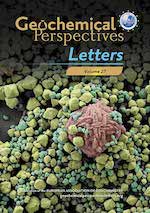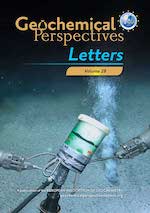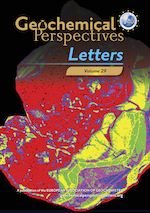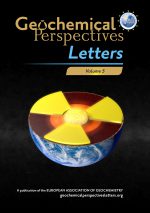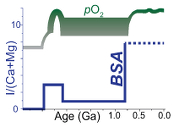 | Iodine proxy evidence for increased ocean oxygenation during the Bitter Springs Anomaly Abstract: The Neoproterozoic Bitter Springs Anomaly (BSA; 810–800 Ma) is characterised by an 8 ‰ negative δ13C excursion and is coeval with multiple indicators of increasing oxygenation of the ocean and atmosphere. Here, we use carbonate iodine contents to provide the first constraints on the evolution of local upper ocean redox conditions spanning the BSA. Iodine speciation in seawater is strongly redox sensitive, and carbonates precipitated proximal to O2-depleted water record low I/(Ca + Mg). Data from the Akademikerbreen Group of Svalbard show a major rise of I/(Ca + Mg) during the recovery phase of the BSA. Other relatively high I/(Ca + Mg) values are also associated with rising δ13C throughout the section. Combined with existing palaeoredox proxies (e.g., Cr and S isotopes), our new iodine data most likely reflect an oxygenation event. |
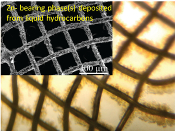 | Hydrocarbons as ore fluids Abstract: Conventional wisdom holds that aqueous solutions are the only non-magmatic fluids capable of concentrating metals in the Earth’s crust. The role of hydrocarbons in metal concentration is relegated to providing geochemical barriers at which the metals are reduced and immobilised. Liquid hydrocarbons, however, are also known to be able to carry appreciable concentrations of metals, and travel considerable distances. Here we report the results of an experimental determination of bulk solubilities of Au, Zn, and U in a variety of crude oils at temperatures up to 300 °C and of the benchtop-scale transport experiments that simulate hydrocarbon-mediated re-deposition of Zn at 25–200 °C. It has been demonstrated that the metal concentrations obtained in solubility experiments are within the range of concentrations that are typically considered sufficient for aqueous fluids to form ore bodies. It has also been shown that Zn can be efficiently transported and re-deposited by hydrocarbons. These results provide direct evidence of the ability of natural crude oils to mobilise metals available in hydrocarbon-associated host rocks, and transport them in concentrations sufficient to contribute to ore-forming processes. |
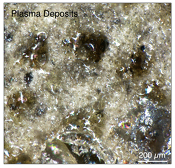 | Ultra-high pressure and ultra-reduced minerals in ophiolites may form by lightning strikes Abstract: Since ultra-high pressure (UHP) minerals have been discovered in ophiolites from Tibet and the Polar Urals, it is speculated that the mantle sections of ophiolites may originate deep within the mantle. The UHP minerals are frequently found together with ultra-reduced silicides, carbides, and nitrides. Consequently, it is argued that the deep mantle, or at least domains within it, must be highly reduced, so reduced that practically all transition elements at depth are present in the metallic state. We find it problematic to rewrite the history of ophiolite complexes based on these observations and suggest we should search for alternative and more realistic modes of origin. Electric discharge experiments at >6000 K reported here show that the UHP and highly reduced phase assemblages may precipitate from plasmas. We argue that the mineral assemblages may originate by lightning strikes. As such, they may not record the origin and emplacement history of the mantle lithologies within which they occur. |
 | Magnetotactic bacteria as a new model for P sequestration in the ferruginous Lake Pavin Abstract: The role of microorganisms in the geochemical cycle of P has received great interest in the context of enhanced biological phosphorus removal and phosphorite formation. Here, we combine scanning and transmission electron microscopies, confocal laser scanning microscopy and synchrotron-based x-ray microfluorescence to analyse the distribution of P at the oxic-anoxic interface in the water column of the ferruginous Lake Pavin. We show that magnetotactic bacteria of the Magnetococcaceae family strongly accumulate polyphosphates and appear as P hotspots in the particulate fraction at this depth. This high accumulation may be characteristic of this family and may also relate to the chemical conditions prevailing in the lake. As a result, these magnetotactic cocci can be considered as new models playing a potentially important role in the P geochemical cycle, similar to sulphide oxidising bacteria such as Thiomargarita and Beggiatoa but thriving in a ferruginous, poorly sulphidic environment. |
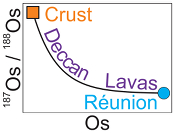 | A geochemical link between plume head and tail volcanism Abstract: Geodynamical models of mantle plumes often invoke initial, high volume plume ‘head’ magmatism, followed by lower volume plume ‘tails’. However, geochemical links between plume heads, represented by flood basalts such as the Deccan Traps, and plume tails, represented by ocean islands such as La Réunion, are ambiguous, challenging this classical view of mantle plume theory. Using Sr-Nd-Os isotope data, we demonstrate a geochemical link between archetypal plume head and tail volcanism in the Réunion hotspot. Similar plume head-tail relationships have not been definitively shown in previous geochemical studies for Réunion or other global hotspots. Such a link is enabled by use of compatible elements, such as Os, which can circumvent complexities introduced by magmatic assimilation of crust or lithosphere because these elements are scarce in crust compared to primary mantle melts. We calculate Sr-Nd-Os isotopic compositions for the Réunion primary magma and find these are identical to predictions for the Deccan primary magma. Our result provides geochemical evidence for a temporally stable mantle plume that samples a primitive reservoir associated with the African large low-shear-velocity province and with a heritage beginning at the Cretaceous-Palaeogene boundary. |
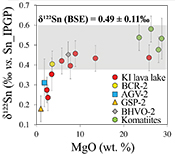 | Tin isotopic fractionation during igneous differentiation and Earth’s mantle composition Abstract: Tin exists both under the 2+ and 4+ oxidation states in igneous systems, and thus its geochemical behaviour changes as a function of oxygen fugacity. To characterise the redox state of Sn during magmatic differentiation and how this affects its isotope composition, we have measured Sn isotopic and elemental abundances in a suite of samples from the Kilauea Iki lava lake. Sn behaves as a highly incompatible element during fractional crystallisation. Lattice strain modelling shows that Sn2+ has mineral-melt partition coefficients (Dmin/melt) ≈1 in plagioclase and clinopyroxene, whereas it is highly incompatible in all phases save for ilmenite, attesting to the sole presence of Sn4+ in basaltic liquid at the Fayalite-Magnetite-Quartz (FMQ) buffer. Furthermore, Sn isotopes are unfractionated during crystallisation of silicates, but decrease to lighter values upon ilmenite precipitation. Isotopic fractionation is onset by the coordination change between Sn4+ in the melt (6- to 8-fold) and ilmenite (6-fold). The Sn isotope composition of komatiites, which are high degree, high temperature partial melts are used to estimate the Sn isotope composition of the bulk silicate Earth (BSE). Komatiites have δ122Sn within the range of the basalts (before ilmenite precipitation) and together provide the best estimate of the BSE of 0.49 ± 0.11 ‰ (2 s.d., n = 9). |
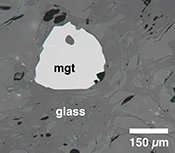 | FeTiMM – A new oxybarometer for mafic to felsic magmas Abstract: The oxidation state of magmas is a key parameter that is notoriously difficult to reconstruct. The most common approach is via magnetite–ilmenite oxybarometry. However, many natural magmas do not contain ilmenite, preventing application of this technique. Here we present a new method that allows fO2 to be reconstructed based on the partitioning of Fe and Ti between magnetite and silicate melt. The new method, which we call FeTiMM, is applicable to both ilmenite-free and ilmenite-bearing samples, and even to slowly cooled intrusive rocks such as granites. FeTiMM was calibrated on 109 experiments covering a wide range of oxygen fugacities, temperatures, pressures and silicate melts ranging from basaltic to rhyolitic composition, and returned fO2 values that agree within 0.5 log units with independently constrained fO2 values in all but five cases. A first test on 19 natural samples of dacitic to rhyolitic compositions was equally successful. FeTiMM thus opens the door for numerous new applications in various disciplines of Earth Sciences, including the fields of volcanology, igneous petrology, experimental geochemistry and ore geology. |
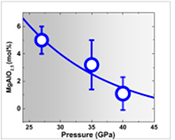 | Rapid decrease of MgAlO2.5 component in bridgmanite with pressure Abstract: The solubility of the MgAlO2.5 component in bridgmanite was measured at pressures of 27, 35 and 40 GPa and a temperature of 2000 oK using an ultra-high pressure multi-anvil press. Compositional analysis of recovered samples demonstrated that the MgAlO2.5 component decreases with increasing pressure, and approaches virtually zero at 40 GPa. Above this pressure, the MgAlO2.5 component, i.e. the oxygen-vacancy substitution, becomes negligible, and Al is incorporated in bridgmanite by the charge-coupled substitution only. These results are supported by the volume change associated with the change from the oxygen-vacancy substitution to charge-coupled substitution. The present result may explain the seismically observed slab stagnation in the mid-lower mantle. Although bridgmanite has been put forward as a potential host for water and argon in the lower mantle by trapping them in oxygen vacancies, such capabilities will rapidly decrease with depth and be lost in regions deeper than 1000 km. |
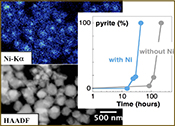 | Nickel accelerates pyrite nucleation at ambient temperature Abstract: Chemical and isotopic compositions of pyrites are used as biogeochemical tracers in Archean to modern sediments. Moreover, pyrite formation from monosulphide precursors has been proposed to be involved in prebiotic chemistry. However, the factors controlling pyrite formation and distribution in the sedimentary record are incompletely understood. Here, we show that Ni2+ ions accelerate ~5 times the nucleation of pyrite at ambient temperature. Using Fe and Ni K-edge EXAFS and TEM-EDXS we demonstrate that Ni(II) is directly involved in the nucleation of pyrite synthesised by reacting Fe(III) with Na2S in the presence of aqueous Ni(II) impurity. Initial formation of a Ni-enriched pyrite core is followed by overgrowth of a Ni-depleted pyrite shell, leading to compositional zoning of the Fe1-xNixS2 nanocrystals (x = 0.05 to 0.0004). The molar Ni/Fe ratio in the final aqueous solution was then 2000 times lower than the starting ratio of 0.01. This enhanced and accelerated trapping of Ni by pyrite could be of prime importance in controlling Ni concentration in the ocean during early diagenesis of marine sediments, and could thus have important implications for interpreting abundances of Ni and pyrite in the sedimentary record. In addition, acceleration of pyrite nucleation in the presence of nickel could help understanding the role of Fe-Ni sulphides in catalysing potential prebiotic reactions. |
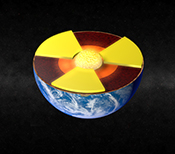 | The solubility of heat-producing elements in Earth’s core Abstract: The long term thermal and dynamic evolution of Earth’s core depends on its energy budget, and models have shown that radioactive decay due to K and U disintegration can contribute significantly to core dynamics and thermal evolution if substantial amounts of heat-producing elements are dissolved in the core during differentiation. Here we performed laser-heated diamond anvil cell experiments and measured K and U solubility in molten iron alloy at core formation conditions. Pyrolitic and basaltic silicate melts were equilibrated with metallic S–Si–O-bearing iron alloys at pressures of 49 to 81 GPa and temperatures of 3500 to 4100 K. We found that the metal-silicate partitioning of K is independent of silicate or metal composition and increases with pressure. Conversely, U partitioning is independent of pressure and silicate composition but it strongly increases with temperature and oxygen concentration in the metal. We subsequently modelled U and K concentration in the core during core formation, and found a maximum of 26 ppm K and 3.5 ppb U dissolved in the core, producing up to 7.5 TW of heat 4.5 Gyr ago. While higher than previous estimates, this is insufficient to power an early geodynamo, appreciably reduce initial core temperature, or significantly alter its thermal evolution and the (apparently young) age of the inner core. |
<< Previous issueNext issue >>


